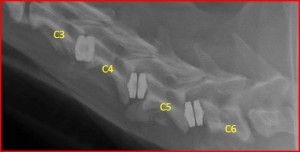ADAMO SPINAL DISC™
ADAMO SPINAL DISC™
The most advanced veterinary spinal implant technology for the treatment of wobbler's syndrome
Adamo Spinal Disc was the first product Applied Veterinary Technology, LLC embraced for dogs with “disc associated wobbler syndrome”. The idea of creating an the Adamo Spinal Disc for dogs came to Dr. Adamo, in 2003, when he was faculty as Clinical Assistant Professor in Neurology/Neurosurgery, at the School of Veterinary Medicine “University of Wisconsin“ Madison, Dr. Adamo, noticed that great progress were made in people with cervical disc diseases by using artificial disc implantation. Dr. Adamo also noticed that dogs, particularly large breed, have a cervical disease, called “disc associated wobbler syndrome” also called “wobbler syndrome”, which are many similarities to a counterpart cervical disease in people called “cervical spondylomyelopathy”.

Adamo Spinal Disc Third Generation

Adamo Spinal Disc Implanted
In people, cervical spondylomyelopathy is best treated with spinal cord decompression and insertion of an artificial disc to provide distraction and mobility at the treated site, this is called cervical disc arthroplasty (CDA).
Dr. Adamo believed that dogs with disc associated wobbler syndrome could also benefit from CDA. However, the cervical prostheses available for people were too large to be applied in dogs, and too expensive for the application in veterinary medicine. Consequently, a new cervical disc dedicated to the canine cervical spine had to be created, at a cost affordable to most of the pet owners but because of the limited market and the low expected revenue, there were no companies or investors interested in founding this project.
However, Dr. Adamo firmly believed that providing the cure for dog with “wobbler syndrome” was a priority, and decided to auto-finance the canine artificial disc project. In 2003, Dr. Adamo designed the first cervical artificial disc for dogs, which was biomechanically tested at the laboratory of the Human Hospital of the University of Wisconsin. This study showed that the insertion of the disc in the canine cervical spine was more effective than other current surgical techniques in restoring the physiologic biomechanical property of the canine cervical spine. (Study published in Veterinary Surgery Journal in 2007)
In 2011, a pilot clinical study in two dogs affected by “disc associated wobbler syndrome” treated with CDA, showed at the 3 year follow-up after surgery, that in both dogs the disc implant successfully restored a “normal neurological status”. In the same study, the MRI repeated 2 years after the disc implantation showed no complication at the treated and at the adjacent disc site. (Study published in JAVMA 2011).

Since 2011, many improvements have been made on the canine artificial disc, additional surgical tools were created to facilitate the surgical technique, and currently a 3rd generation of the canine cervical disc is available. The CDA is now performed in many neurology veterinary centers in USA and UK.
Advantages and Benefits of Cervical Disc Arthroplasty in dogs affected by disc associated Wobbler Syndrome include:








Less invasive than traditional surgeries
Can be performed on an out-patient basis
Can be performed on an out-patient basis
Can be used for the treatment of multiple cervical discs lesions, adjacent, non-adjacent sites
Provide spinal cord decompression and dynamic distraction
Provide spinal cord decompression and dynamic distraction
Provide immediate relief of radicular pain and vascular compression at the intervertebral foramina
Enable MRI re-assessment for complications for long term re-assessment of domino lesions
Other benefits:
- Improved pet-owner willingness to pursuing the surgical option
- Changed the prognosis for dogs with disc associated wobbler syndrome, once poor, in good!




